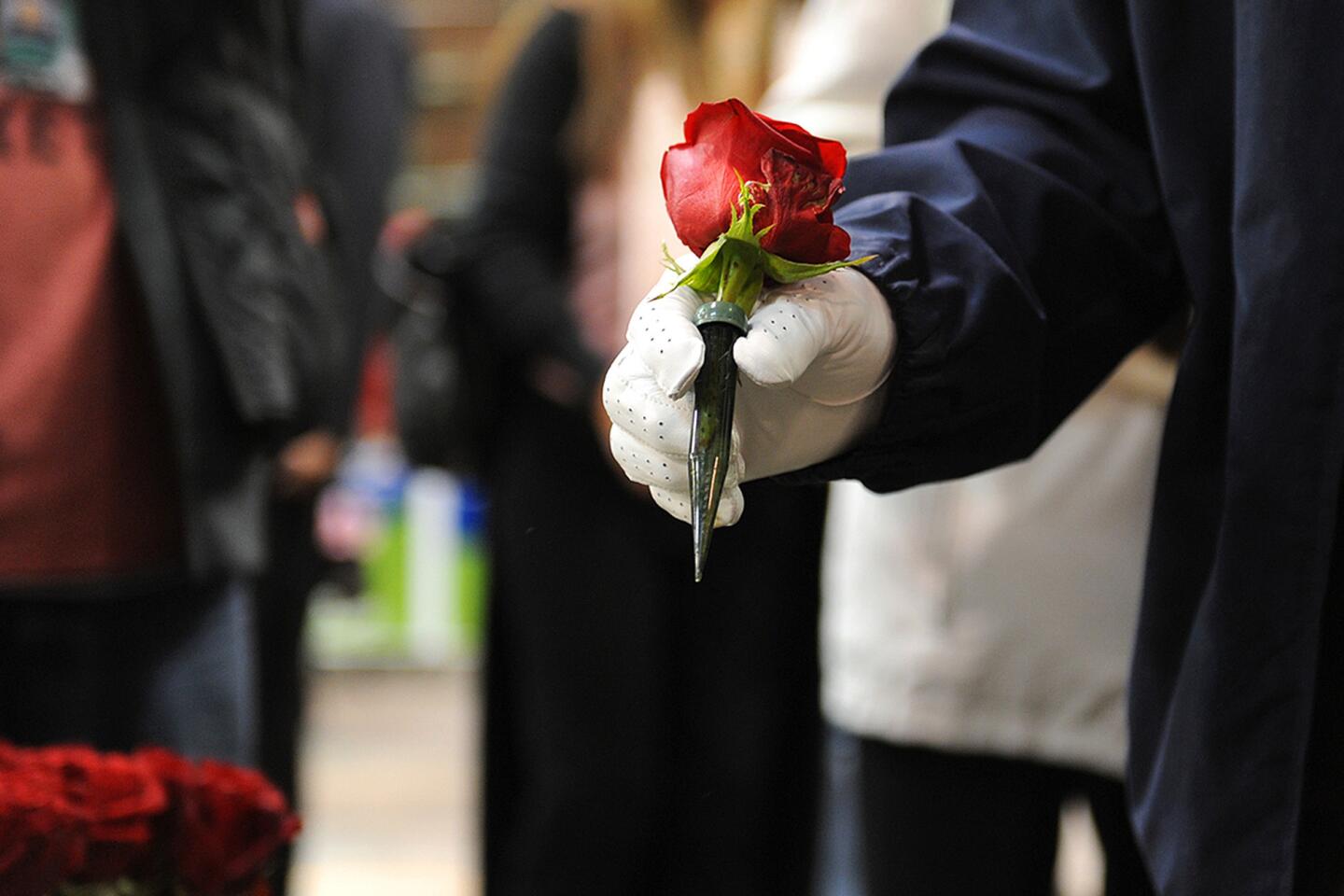World War II veterans show pride with ‘Go for Broke’ Rose Parade float
- Share via
In a frigid barn near the Rose Bowl in Pasadena, members of the Japanese American community looked on with pride Sunday as four of five World War II veterans riding in the 126th Rose Parade each placed a flower on the “Go for Broke” float.
Among the crowd was Susan Uyehara-Contreras of Walnut, whose father, Kazuo Uyehara, served in Company B of the 442nd Regimental Combat Team. A day earlier, she and her family had helped decorate the bald eagle that tops the float. Her dad died four years ago.
“He would have been in awe,” she said.
“They are the forgotten heroes,” said her husband, Jose Luis Contreras.
The surviving Nisei veterans arrived with friends and family at the Rosemont Pavilion on Sunday for the float’s festive dedication. Some of them were selected to participate in the New Year’s Day parade after a nationwide search.
Thousands will line Pasadena’s streets this week to honor the veterans for their service, but the men themselves said the main reason for their participation is to recognize the sacrifice of others like Uyehara. The 442nd is among the most highly decorated units in U.S. military history for its size and length of service, with more than 9,400 Purple Heart recipients and 21 Medals of Honor.
“There’s a special obligation we felt on our shoulders that we as Japanese Americans should sacrifice for our country. And we tried to give it everything we had,” says Yoshio Nakamura, 89, a San Gabriel Valley native who was a member of the 442nd. “But there are so many more who are not with us today — or who are no longer with us — who are far more deserving. When I ride, I will do it in honor of their spirit.”
Yosh, as his friends know him, fought in battles that ultimately broke the Nazis’ last line of defense in Northern Italy. Like some of his fellow honorees, he enlisted later in the war, in 1944, shortly after the U.S. government accepted Japanese Americans who had been in internment camps. He, his parents and siblings were first housed in horse stalls at the Tulare Assembly Center and then moved to the Gila River Relocation Center. He remembers eagerly donning his Army uniform, ready to prove his loyalty.
Around that time, after imprisonment at Manzanar in California, Masao Takahashi was drafted into the 100th Battalion. After finishing basic training at Ft. Blanding in Florida, he was sent overseas to serve in France and Italy. Both he and Nakamura toiled in an environment in which many civilians and officers looked at them with suspicion, questioning their patriotism because of their Japanese ancestry. Yet the Nisei soldiers remained steadfast, never complaining.
“We had a mission. Everyone was fighting for a common cause: to win the war,” said Takahashi, 90.
Veteran Toke Yoshihashi, 91, born in Pasadena, just a few miles from the parade route, says he’s participating — reluctantly. “I am grateful, but the credit belongs to others,” he said. “Going in the Army, our choice was either infantry or artillery. Neither the Navy or Air Force wanted us. I had to put all the negatives aside.”
Yoshihashi joined the 100th Battalion in Epinal, France, and by March 1945 he had returned to Livorno, Italy, to aid the Fifth Army in its campaign to break the Gothic Line.
“A lot of people may not even be aware that Japanese Americans made tremendous contributions,” says Don Nose, president of the Go for Broke National Education Center who helped the city of Alhambra — the sponsor — put the float together. “Despite incredible adversity, and with civil rights violated, they never said, ‘We’re being discriminated against — we’re not going to step up.’ They just did it.”
Nose said Alhambra’s mayor, Gary Yamauchi, had the idea of highlighting the veterans’ service. For entries, parade organizers announced they were looking for inspirational stories after choosing their grand marshal, the late Louis Zamperini, a World War II legend and the subject of the Hollywood movie “Unbroken.”
Nose and his team took city officials to Little Tokyo, site of the group’s stirring monument containing the names of more than 14,000 Japanese Americans who served in World War II. The 41-foot Rose Parade float is a replica of the black granite statue, also named “Go for Broke,” evoking the veterans’ battle cry that reflected their willingness to give their all for their country.
“We dedicated our all,” said Takahashi, who’s very shy about standing in full view aboard the float.
“The men I know are humble and don’t think they should get recognition,” says his son, Scott Takahashi, an Army artillery gunner and Vietnam veteran. “They all think it’s a good idea, but then they all say someone else should ride.”
Slowly, Nakamura practices “a bit of waving so my arm doesn’t get too heavy.” Long a home spectator, watching the parade in his pajamas, he says: “I’m looking forward to representing the real heroes of the 442nd.
“I hope they will hear all the cheers.”
More to Read
Sign up for Essential California
The most important California stories and recommendations in your inbox every morning.
You may occasionally receive promotional content from the Los Angeles Times.




















